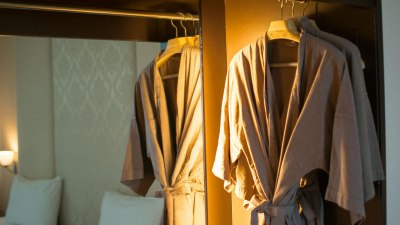Why No One Ever Actually Uses That Fancy Hotel Bathrobe
Explore the curious phenomenon of hotel bathrobe usage and why they often remain untouched.

When you step into a luxurious hotel room, one of the many appealing features is the plush bathrobe hanging in the wardrobe. It exudes comfort and relaxation, promising a sense of indulgence that often accompanies a stay in such establishments. However, many guests find themselves admiring the robe from a distance, opting never to wear it. This paradox of hotel stays raises questions about the reasons behind this widespread behavior. Why do we hesitate to slip into that luxurious robe waiting for us?
To understand the mystery of the neglected hotel bathrobe, we must explore several factors that contribute to this phenomenon. First and foremost is the psychological aspect of being in a different environment. For many travelers, staying in a hotel is a significant departure from their ordinary lives. The surroundings are new, and the experience is often marked by excitement and novelty. All these factors can lead to a reluctance to engage with the implicit form of relaxation that a bathrobe signifies, as it can feel too comfortable and perhaps even too intimate for the temporary space.
The Significance of Comfort
When we discuss comfort, the hotel bathrobe represents a luxury that is typically reserved for moments of indulgence. The thought of putting one on may evoke feelings akin to those of settling into the comfort of one’s own home. For many, this juxtaposition leads to an internal conflict: do we embrace the comfort that the hotel bathrobe offers, or do we maintain a sense of formality and reserve typically associated with being out in public, no matter how private our hotel room may feel?
Moreover, the fabric of the bathrobe itself plays a crucial role in its allure and in our hesitance to use it. Hotel bathrobes are often made from high-quality materials such as cotton or plush terry cloth designed to feel soft against the skin. Yet, this tactile luxury can ironically deter some guests from using them as they may perceive their own hygiene standards and those of the robe's previous users. This concern can overshadow the inviting appearance of the robe, leading to it remaining on the hanger untouched.
The Perception of Value
Another significant aspect of hotel bathrobes is the perception of value associated with them. Guests often recognize that these robes are part of a premium experience, and such items come with an implicit understanding that they are offerings reserved for the most opulent stays. This association can lead to a mindset where the robe becomes more of a decorative item rather than a wearable comfort. The mere presence of the robe becomes a symbol of luxury that reinforces the hotel’s brand and image, yet not something travelers feel worthy to engage with.
In many cases, while a guest may feel entitled to use the robe, they also harbor a sense of uncertainty regarding the potential for extra charges, especially if they mistakenly believe the robe is not complimentary. This uncertainty can further inhibit the likelihood of actually wearing the bathrobe. Without clear communication from hotel staff about policies concerning the use of bathrobes, guests may opt to leave it be, thus missing out on an opportunity for a cozy experience.
Social Influences
Social norms undoubtedly impact behavior during hotel stays. The communal aspect of traveling often influences individual actions. People are hesitant to change into bathing suits around strangers or peers because they feel exposed; similarly, the luxury of wearing a bathrobe in a hotel room may feel too intimate or relaxed for some individuals who would rather maintain a certain image. Friends and family dynamics can play a critical role in hotel stays, where the collective perception and behavior significantly influence individual experiences.
Additionally, some guests might refrain from using the bathrobe because they want to keep the experience special or preserve the robe’s pristine condition for future guests. This idea of maintaining a sense of purity to the experience is another psychological barrier that prevents bathrobe use. Guests may feel that wearing the robe would somehow diminish its specialness, relegating it to an everyday item instead of a luxurious hotel amenity.
The Impact of Activities
The intended purpose of the hotel bathrobe could also affect its usage. Guests at spa hotels, resorts, or wellness retreats may be more inclined to wear a bathrobe during their stay, as the setting fosters relaxation. Conversely, those traveling for business or connecting with family often engage in various activities that shift focus away from leisurely interactions with amenities like bathrobes. Busy schedules and activities tend to incentivize getting dressed and moving about rather than lounging comfortably in a robe for hours.
Moreover, hotel guests may find themselves constrained by time. The logistics of traveling can impede the opportunity to indulge in leisurely activities, such as enjoying the amenities that come with a fluffy bathrobe. Guests often find themselves preoccupied with dining arrangements, meetings, and explorations of the local attractions, prompting them to prioritize mobility over comfort.
The Evolution of Travel Preferences
Travel preferences have evolved significantly in recent years. The rise of budget accommodations and home-sharing services has altered the landscape of travel. The luxury and allure associated with high-end hotels may continue to exist, yet many guests, especially younger generations, find themselves gravitating toward more casual experiences. This shift in traveler preferences often minimizes the relevance of hotel amenities such as bathrobes, which are often seen as an unnecessary extra by budget-conscious travelers.
For some, a more casual experience means less reliance on hotel luxuries and amenities. The mentality of sacrificing comfort for the sake of affordability leads many to forgo taking advantage of items that once represented luxury, such as the bathrobe. This trend, paired with the informal nature of alternate accommodations, undermines the traditional hotel experience and further distances travelers from utilizing these amenities.
Conclusion: Embracing the Rest
In conclusion, the absence of hotel bathrobe usage presents an intriguing lens through which to explore customer psychology and behavior in the hospitality industry. Factors such as personal comfort levels, the perception of luxury versus reality, social influences, and evolving travel preferences all contribute to why guests often bind themselves to a state of formality during their stay rather than embracing the cozy comfort of a hotel bathrobe.
This paradox reveals not only the dynamics of marketing and the appeal of luxury but also the complexities of human behavior and decision-making in unfamiliar environments. By acknowledging the multitude of influences we face when staying in a hotel, we gain insight into a broader understanding of comfort, possession, and the ever-evolving nature of travel experiences.
Whether we choose to wear it or leave it hanging, the hotel bathrobe represents more than just a piece of clothing; it symbolizes the tension between indulgence and reservation that defines the modern travel experience.











